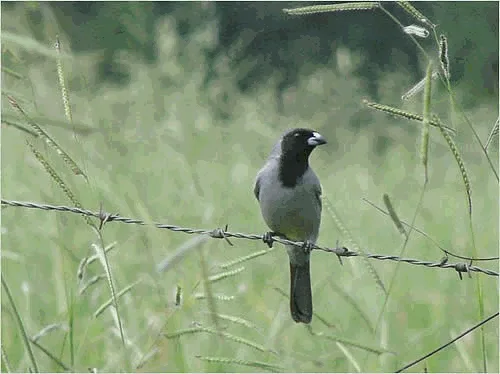
Black-faced Tanager

[order] Passeriformes | [family] Thraupidae | [latin] Schistochlamys melanopis | [UK] Black-faced Tanager | [FR] Tangara a camail | [DE] Schleiertangare | [ES] Frutero de Cara Negra | [IT] Tangara faccianera | [NL] Sluiertangare
Subspecies
| Genus | Species | subspecies | Breeding Range | Breeding Range 2 | Non Breeding Range |
| Cissopis | melanopis | ||||
| Schistochlamys | melanopis | SA | n, c, e | ||
| Schistochlamys | melanopis | amazonica | |||
| Schistochlamys | melanopis | aterrima | |||
| Schistochlamys | melanopis | grisea | |||
| Schistochlamys | melanopis | melanopis | |||
| Schistochlamys | melanopis | olivina |
Physical charateristics
Unmistakable. It is mainly grey with a black forehead, face, and throat and part of upperbreast. . The bill is blue-grey with a darker tip.
Listen to the sound of Black-faced Tanager
[audio:http://www.aviflevoland.nl/sounddb/B/Black-faced Tanager.mp3]
Copyright remark: Most sounds derived from xeno-canto
| wingspan min.: | 0 | cm | wingspan max.: | 0 | cm |
| size min.: | 19 | cm | size max.: | 20 | cm |
| incubation min.: | 0 | days | incubation max.: | 0 | days |
| fledging min.: | 0 | days | fledging max.: | 0 | days |
| broods: | 1 | eggs min.: | 2 | ||
| eggs max.: | 3 |
Range
It is found in Bolivia, Brazil, Colombia, Ecuador, French Guiana, Guyana, Paraguay, Peru, Suriname, and Venezuela
Habitat
Its natural habitats are subtropical or tropical moist lowland forests, dry savanna, and subtropical or tropical dry shrubland. It is found in open areas with bushes and low scrubby trees such as cerrado
Reproduction
Nest is an open cup made of grass. Usually build low above ground in shrub near open places. Clutch size is two eggs.
Feeding habits
It generally lives in pairs foraging for fruit and berries and an occasional insect.
Conservation
This species has a large range, with an estimated global extent of occurrence of 6,200,000 km². The global population size has not been quantified, but it is believed to be large as the species is described as ‘frequent’ in at least parts of its range (Stotz et al. 1996). Global population trends have not been quantified, but the species is not believed to approach the thresholds for the population decline criterion of the IUCN Red List (i.e., declining more than 30% in ten years or three generations). For these reasons, the species is evaluated as Least Concern.

Migration
Sedentary throughout range
Distribution map

